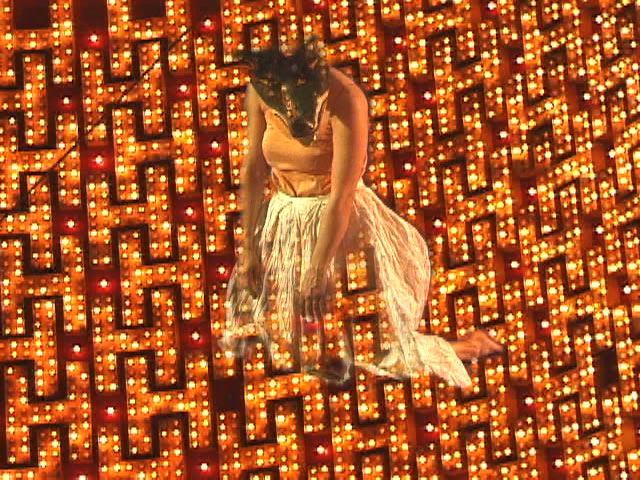“Good Night… Good Morning,” says Joan Jonas (NA 2012) in the last work of her recent survey at the Tate Modern, curated by Andrea Lissoni and Julienne Lorz, with Monika Bayer-Wermuth. A recreation of her 1976 video, My New Theater VI: Good Night Good Morning ‘06, 2006, is a sequence of salutations, made over consecutive mornings and evenings. Jonas appears to address the viewer, but in fact speaks to the camera, which in turn records views of her Nova Scotia home from different angles refracted in a convex mirror. While the earlier work—which also formed part of her complex multi-media performance Mirage—shows the artist wake and sleep in various modes of dress and sobriety, dutifully tracing the passage of time, the later work is much more playful. Installed in one of the sculptural viewing structures from her My New Theater series, made since 1997, the work invites you to take a seat and meet the image of the artist as she appears suspended in the strange, refracted world seen through her camera.

This work makes for an apposite end of the exhibition. Not only does it send the viewer off with personal address, it suggests the importance of video and other mediatory technologies for Jonas’ performative mode. Unlike the ground breaking 1994 Stedelijk Museum exhibition of Jonas’ work, which asserted her importance as a performance artist—and launched a thousand questions around the display and acquisition of performance art in the museum—the Tate Modern exhibition neither features many of the artist’s ‘stage sets,’ nor much archival material or documentation, barring the second room, which includes Tate’s version of The Juniper Tree, 1976/1994, evocative framed photographs of the site-specific performances of the 1970s, and the infamous Organic Honey’s Visual Telepathy, 1972, in which the artist performs a masquerade of hyper-femininity taped by Babette Mangolte. The other rooms of the exhibition focus on Jonas’ videos, her My New Theate works, and her multi-media installations. This makes for a complex installation that isn’t always successful in marshalling the competing elements of Jonas’ works, especially those that rely upon the layering of screens and objects, as well as layered visual and textual references as in Helen in Egypt: Lines in the Sand, 2004.

Clearly Jonas’ work could not be contained by the measly space in the new Blatnavik Building extension—Modigliani and Picasso had taken over the main galleries—and the curators included a more spacious installation of Reanimation, 2010/2012/2013, and Wind, 1968, in the Turbine Hall galleries downstairs. These displays were the most successful in the exhibition, given space and the industrial scale similar to the New York of the 1970s and 1980s that Jonas’ work has long been associated with. Jonas’ performances in the Turbine Hall (Mirage was performed by the artist for the first time since 1976; while Mirror Check, 1970, and Mirror Piece, 1969 –1970, were performed by dancers in the program I saw) and the restaging of her Delay Delay, 1972, on the Thames beach outside the museum, broke the hushed reverence of black and white photography, replacing it with the humor, stun, and anxiety variously solicited by Jonas’ work.

The live art program was spectacular, but the exhibition and displays of Jonas’ work presented a shadow side of the artist, which was not always fully explored. At once technologically innovative, and obsessed by fable, myth, and legend—sometimes attuned to comedy and sometimes sounding an uncomfortably orientalist note—Jonas’ work warrants more space, and the extended viewing time for which a larger set of gallery spaces would have allowed. Her work is not simply a Postmodernist melange of references and shouldn’t be compacted, as it was here, into so many approaches to narrative and storytelling. Nonetheless, I enjoyed some of the smaller-scale My New Theaters the best. Leaning in to watch My New Theater V: Moving in Place (Dog Dance), 2002 – 2005, in which Jonas dances frantically on a sped-up video while her dog looks on in confusion, was slapstick-funny and absolutely uplifting. But hiding in a corner of the gallery to watch My New Theater III: In the Shadow a Shadow, 1999, was an unexpected bliss. In this video Jonas performs a tricky choreography, made more strange by more sped-up video, with the dancer Maris Vachon. The two figures trip across a wooden cabin, exchanging spaces and interacting with the furniture placed and replaced by the other, all to the soundtrack of Kurt Schwitters’ Ursonate. With all her changes of outfit, quick cuts, and shamanesque drawing sequences, Jonas plays the techno-geek-esoteric-artist, while Vachon embodies the Jonas of the Mirror Check era. Both women at once, both things together, looking back to see something new. “Good Night… Good Morning,” says Joan Jonas.
Joan Jonas was presented at the Tate Modern in London March 14 – August 5, 2018.
Amy Tobin, PhD, holds a joint post at the University of Cambridge as Lecturer in Modern and Contemporary Art in the Department of History of Art, and Curator at Kettle’s Yard.
Reproduction, including downloading of ARS member works is prohibited by copyright laws and international conventions without the express written permission of Artists Rights Society (ARS), New York.
